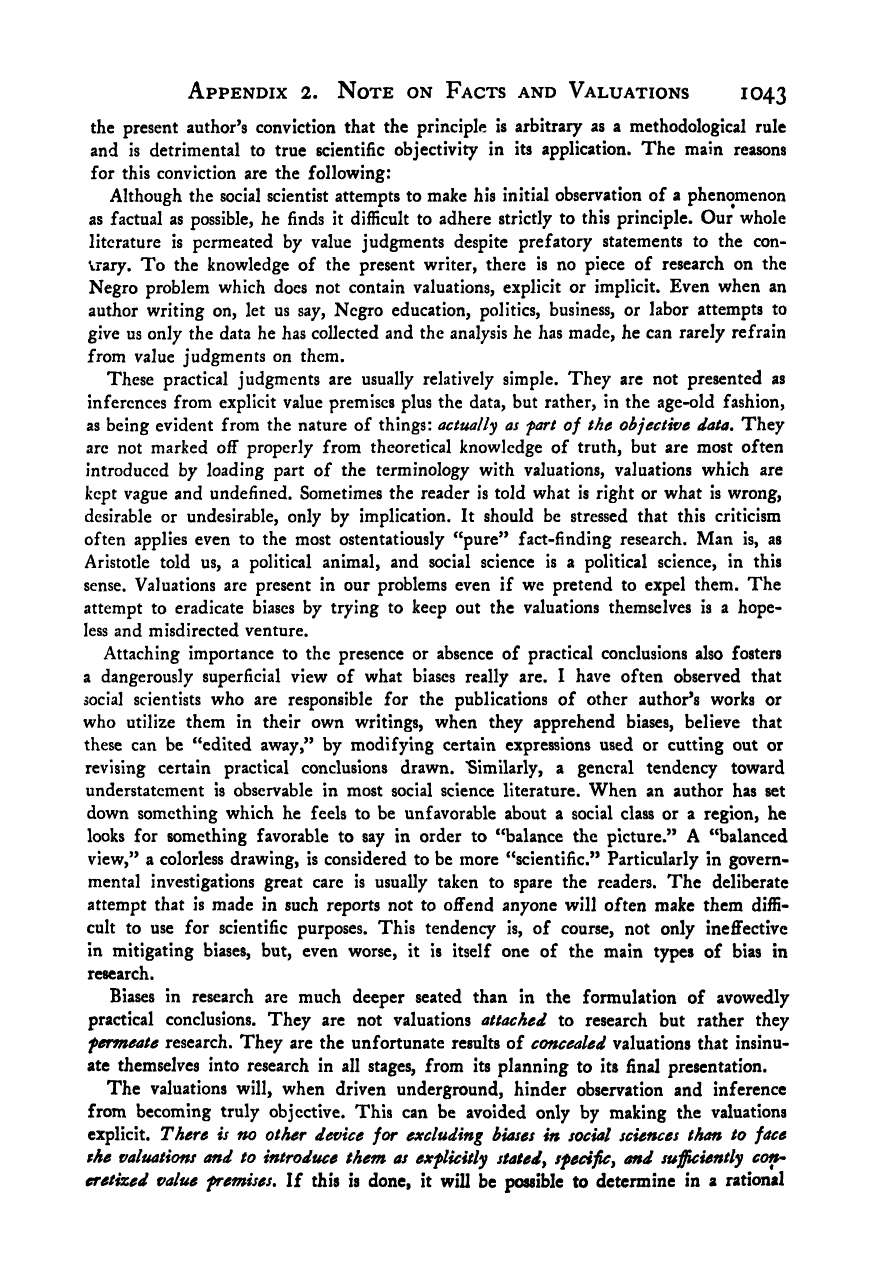Note: Gunnar Myrdal died in 1987, less than 70 years ago. Therefore, this work is protected by copyright, restricting your legal rights to reproduce it. However, you are welcome to view it on screen, as you do now. Read more about copyright.
Full resolution (TIFF) - On this page / på denna sida - Appendices - 2. A Methodological Note on Facts and Valuations in Social Science - 2. Methods of Mitigating Biases in Social Science

<< prev. page << föreg. sida << >> nästa sida >> next page >>
Below is the raw OCR text
from the above scanned image.
Do you see an error? Proofread the page now!
Här nedan syns maskintolkade texten från faksimilbilden ovan.
Ser du något fel? Korrekturläs sidan nu!
This page has never been proofread. / Denna sida har aldrig korrekturlästs.
Appendix 2. Note on Facts and Valuations 1043
the present author’s conviction that the principle is arbitrary as a methodological rule
and is detrimental to true scientific objectivity in its application. The main reasons
for this conviction are the following:
Although the social scientist attempts to make his initial observation of a phenomenon
as factual as possible, he finds it difficult to adhere strictly to this principle. Our whole
literature is permeated by value judgments despite prefatory statements to the con-
Vrary. To the knowledge of the present writer, there is no piece of research on the
Negro problem which does not contain valuations, explicit or implicit. Even when an
author writing on, let us say, Negro education, politics, business, or labor attempts to
give us only the data he has collected and the analysis he has made, he can rarely refrain
from value judgments on them.
These practical judgments are usually relatively simple. They are not presented as
inferences from explicit value premises plus the data, but rather, in the age-old fashion,
as being evident from the nature of things: actually as fart of the objective data. They
are not marked off properly from theoretical knowledge of truth, but are most often
introduced by loading part of the terminology with valuations, valuations which are
kept vague and undefined. Sometimes the reader is told what is right or what is wrong,
desirable or undesirable, only by implication. It should be stressed that this criticism
often applies even to the most ostentatiously “pure” fact-finding research. Man is, as
Aristotle told us, a political animal, and social science is a political science, in this
sense. Valuations are present in our problems even if we pretend to expel them. The
attempt to eradicate biases by trying to keep out the valuations themselves is a hope-
less and misdirected venture.
Attaching importance to the presence or absence of practical conclusions also fosters
a dangerously superficial view of what biases really are. I have often observed that
social scientists who are responsible for the publications of other author’s works or
who utilize them in their own writings, when they apprehend biases, believe that
these can be “edited away,” by modifying certain expressions used or cutting out or
revising certain practical conclusions drawn. ’Similarly, a general tendency toward
understatement is observable in most social science literature. When an author has set
down something which he feels to be unfavorable about a social class or a region, he
looks for something favorable to say in order to “balance the picture.” A “balanced
view,” a colorless drawing, is considered to be more “scientific.” Particularly in govern-
mental investigations great care is usually taken to spare the readers. The deliberate
attempt that is made in such reports not to offend anyone will often make them diffi-
cult to use for scientific purposes. This tendency is, of course, not only ineflfectivc
in mitigating biases, but, even worse, it is itself one of the main types of bias in
research.
Biases in research are much deeper seated than in the formulation of avowedly
practical conclusions. They are not valuations attached to research but rather they
fermeate research. They are the unfortunate results of concealed valuations that insinu-
ate themselves into research in all stages, from its planning to its final presentation.
The valuations will, when driven underground, hinder observation and inference
from becoming truly objective. This can be avoided only by making the valuations
explicit. There is no other device for excluding biases in social sciences than to face
the valuations and to introduce them as exflicitly stated^ sfecificy and sufficiently con^
eretized value fremises. If this is done, it will be possible to determine in a rational
<< prev. page << föreg. sida << >> nästa sida >> next page >>